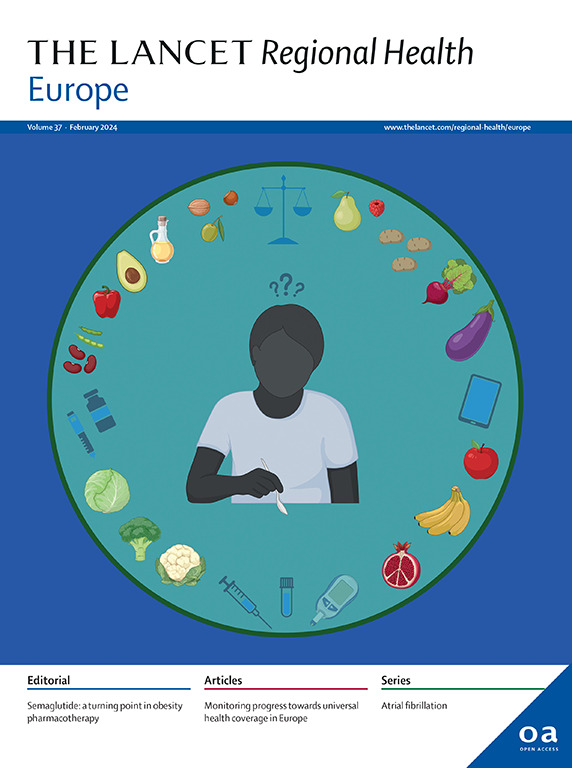2019冠状病毒病大流行之前、期间和之后(2014-2024年)英国髋部骨折发病率的趋势和变化:一项基于人群的观察性研究
IF 13
Q1 HEALTH CARE SCIENCES & SERVICES
引用次数: 0
摘要
背景:髋部骨折是老年人常见的严重损伤。2019冠状病毒病大流行对髋部骨折预防服务产生了重大影响,但有关发病率的当代数据很少。我们调查了英国髋部骨折发病率的最新趋势和变化。方法采用2014年1月- 2024年10月英国国家二级医疗数据,对≥50岁成人髋部骨折住院病例进行基于人群的研究。比较了大流行前(2014年1月至2020年2月)、大流行期间(2020年3月至2021年7月)和大流行后时期(2021年8月至2024年10月)的发病率趋势。研究人员还探讨了年龄、性别和地区剥夺程度的差异。从2014年到2024年,669,101例患者中发生704,762例髋部骨折。从2014年到2019年,年龄标准化发病率从每月28.0-26.4 / 10万人的平均发病率稳步下降。发病率在大流行期间低于预期水平(IRR 0.96, 95% CI 0.94-0.97),但在大流行后时期高于预期水平(IRR 1.03, 95% CI 1.01-1.04),导致2021年8月至2024年10月髋部骨折比预期多5595例。髋部骨折在女性中更为常见,但时间趋势在性别上是一致的。与最贫困的五分之一相比,最贫困的五分之一的发病率更高;到2024年,这些不平等在很大程度上保持不变(男性IRR, 95% CI 1.67 [1.45-1.93];女性为1.30[1.19-1.42])。本研究强调了自2019冠状病毒病大流行以来髋部骨折住院病例的增加,尽管总体上长期呈下降趋势,但由于剥夺而导致的发生率持续存在差异。需要更公平的预防策略,例如通过更广泛的骨折风险筛查和更好的骨折联络服务覆盖。作者由英国国立卫生研究院牛津BRC支持。本文章由计算机程序翻译,如有差异,请以英文原文为准。
Trends and variation in the incidence of hip fracture in England before, during, and after the COVID-19 pandemic (2014–2024): a population-based observational study
Background
Hip fractures are a common serious injury in older adults. The COVID-19 pandemic had a substantial impact on hip fracture prevention services, but contemporary data on incidence are scarce. We investigated recent trends and variation in the incidence of hip fracture in England.
Methods
A population-based study was conducted of hip fracture hospital presentations in adults aged ≥50 years using English national secondary care data (January 2014–October 2024). Trends in incidence were compared across pre-pandemic (January 2014–February 2020), pandemic (March-2020–July-2021), and post-pandemic periods (August 2021–October 2024). Variation by age, sex, and area-level deprivation were explored.
Findings
From 2014 to 2024, there were 704,762 hip fractures in 669,101 patients. Age-standardised incidence rates steadily declined from 2014 to 2019 from a mean monthly rate of 28.0–26.4 per 100,000 population. Incidence rates were below expected levels during the pandemic (IRR 0.96, 95% CI 0.94–0.97) but above expected levels in the post-pandemic period (IRR 1.03, 95% CI 1.01–1.04), resulting in 5595 more hip fractures than expected from August 2021 to October 2024. Hip fractures were more common in women, but temporal trends were consistent by sex. Incidence rates were higher in the most compared with the least deprived quintile; these inequalities remained largely unchanged by 2024 (IRR, 95% CI 1.67 [1.45–1.93] in men; 1.30 [1.19–1.42] in women).
Interpretation
This study highlights an excess of hip fracture presentations to hospital since the COVID-19 pandemic, and continued disparities in incidence by deprivation, despite an overall decreasing long-term trend. More equitable prevention strategies are needed, such as through more widespread screening for fracture risk and better coverage of fracture liaison services.
Funding
Authors are supported by the NIHR Oxford BRC.
求助全文
通过发布文献求助,成功后即可免费获取论文全文。
去求助
来源期刊

Lancet Regional Health-Europe
Multiple-
CiteScore
19.90
自引率
1.40%
发文量
260
审稿时长
9 weeks
期刊介绍:
The Lancet Regional Health – Europe, a gold open access journal, is part of The Lancet's global effort to promote healthcare quality and accessibility worldwide. It focuses on advancing clinical practice and health policy in the European region to enhance health outcomes. The journal publishes high-quality original research advocating changes in clinical practice and health policy. It also includes reviews, commentaries, and opinion pieces on regional health topics, such as infection and disease prevention, healthy aging, and reducing health disparities.
 求助内容:
求助内容: 应助结果提醒方式:
应助结果提醒方式:


